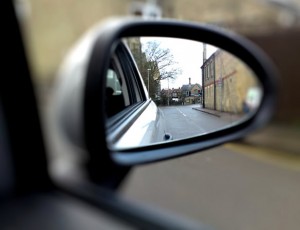Car wing mirrors, or door mirrors as they are mounted on doors on modern vehicles can easily be knocked off. Another vehicle driving too close, or someone opening their door as you drive passed can easily take a mirror off.
Other than the inconvenience and potential financial burden, there are of course the legal implications involves for driving without a wing mirror. As a general rule, if a vehicle has them fitted as factory standard, they must be there and in a safe and usable condition, which is why classic cars are exempt as wing mirrors may not have been fitted originally.
Of course, all modern cars have them fitted as standard. Obligatory mirrors are those that must be fitted and in working order to class a car as roadworthy, to pass and MOT and to be legal on public roads.
Obligatory mirrors are the interior mirror and the drivers-side exterior mirror. UK cars, the driver is seated on the right making the offside exterior wing / door mirror a legal requirement.
The opposite exterior mirror applies for a left-hand drive car. Whether your car has the required mirrors to enable the driver effective rear observation and therefore legal, the police may still stop you.

It’s not just about effective rear view observation for the driver, but any remaining structural materials or debris still secured to the car. Any remains of the wing mirror may pose hazardous to pedestrians or cyclists that may be injured if come in contact. Locations where this may occur could be, but not limited to a busy junction where cyclists, pedestrians and cars are in close vicinity.
It’s essentially up to police discretion on how they deal with this issue, whether it is a legal issue in terms of appropriate mirrors to remain roadworthy or/and if the vehicle represents a hazard to other road users and pedestrians. Penalty points on a licence and fines are highly unlikely unless other issues are found with the vehicle. The matter is likely to be dealt with via a Vehicle Defect Rectification notice.
The Vehicle Defect Rectification Scheme (VDRS) requires that the defect is fixed within 14 days of the notice being issued and signed off by an official MOT station engineer to ascertain proof that the defect has been rectified to a legal and roadworthy condition. If the matter is rectified within the specified time, that will be the end of it. If not, the likely scenario is to receive a court summons.
A Vehicle Defect Rectification notice is issued only for minor defects to a vehicle. A Fixed Penalty Notice resulting in a fine and possible penalty points are issued for more severe issues or a Notice of Driving Prohibition that prevents the vehicle from being driven.
INFORMATION RELATED TO DRIVING OFFENCES
- Driving offences
- Driving without insurance
- Driving without tax
- Driving without an MOT
- Running a red light
- Driving without a licence
